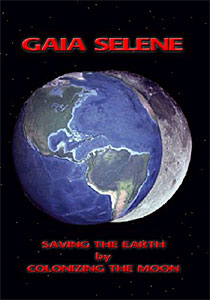Review: Gaia Seleneby Douglas Jobes
|
| Gaia Selene makes a strong argument that humanity must now focus tightly on, and gain mastery of, the heavens. |
The renowned British astrophysicist Stephen Hawking once said he did not believe humanity would survive the next thousand years unless it moved into space. Proser and his experts underscore Hawking’s dire prediction by noting the accelerating increase in the world’s population, the rapid pace of extinction of animal species, the increasing violence of hurricanes and other extremes of weather, the loss of vast stretches of ocean coral, the growing size of the hole in the ozone layer, and many other troubling phenomena. Furthermore, as more and more of the Third World becomes connected to the worldwide power grid, the demand for electricity will skyrocket, far outpacing anyone’s ability to provide it. Humanity’s vast oil reserves are predicted to run out before the turn of the next century, leaving the Earth in desperate straits for energy. Not to mention that over the next century there is a 1-in-455 chance of a cataclysmic asteroid impact ending all life on Earth.
Finding solutions for these problems begins with an examination of the resources and threats in space and on our near neighbor, the Moon. Gaia Selene makes a strong argument that humanity must now focus tightly on, and gain mastery of, the heavens. Concepts such as beaming solar power from the Moon to the Earth to provide energy, developing helium-3 fusion technology to generate clean nuclear power, building settlements on the Moon to provide an expansion valve for humanity, and even converting threatening near Earth asteroids into sources of metals and carbon compounds for industry—these and other ideas are explored in detail.
In addition to the discussions and interviews that form the main body of the documentary, Proser has included additional features many will find useful. A number of scientific papers in PDF format are included, accessible when the DVD is loaded on a PC. There is an intriguing slide show illustrating various space structures and lunar activities, with both artist paintings and computer-generated renderings. (In fact, throughout the DVD are computer animations and illustrations of every kind.) There is even a short section of “online links” that can be used from a PC to access related web sites.
By barreling into our technological future unchecked, humanity risks running out of the resources that the Earth has to provide. The Earth is finite, but the ability of humans to reproduce and to use more and more energy seems limitless. There are risks from without, such as asteroid impacts, which we must also take into account. As a species, we must accept responsibility for our future and exert control over these forces. The lives of our children, grandchildren, and the very fate of humanity depends on it. That is the lesson of Gaia Selene.
